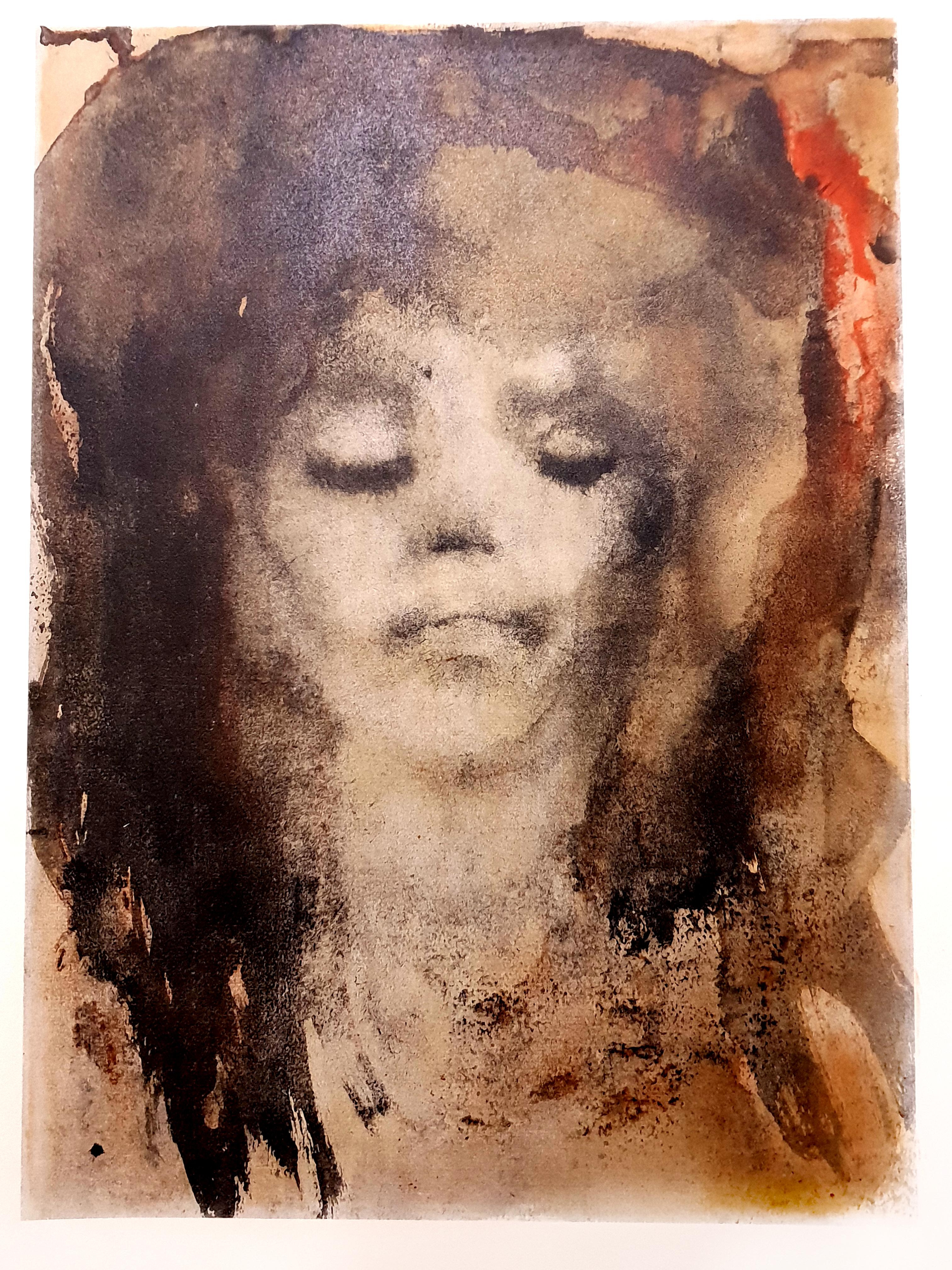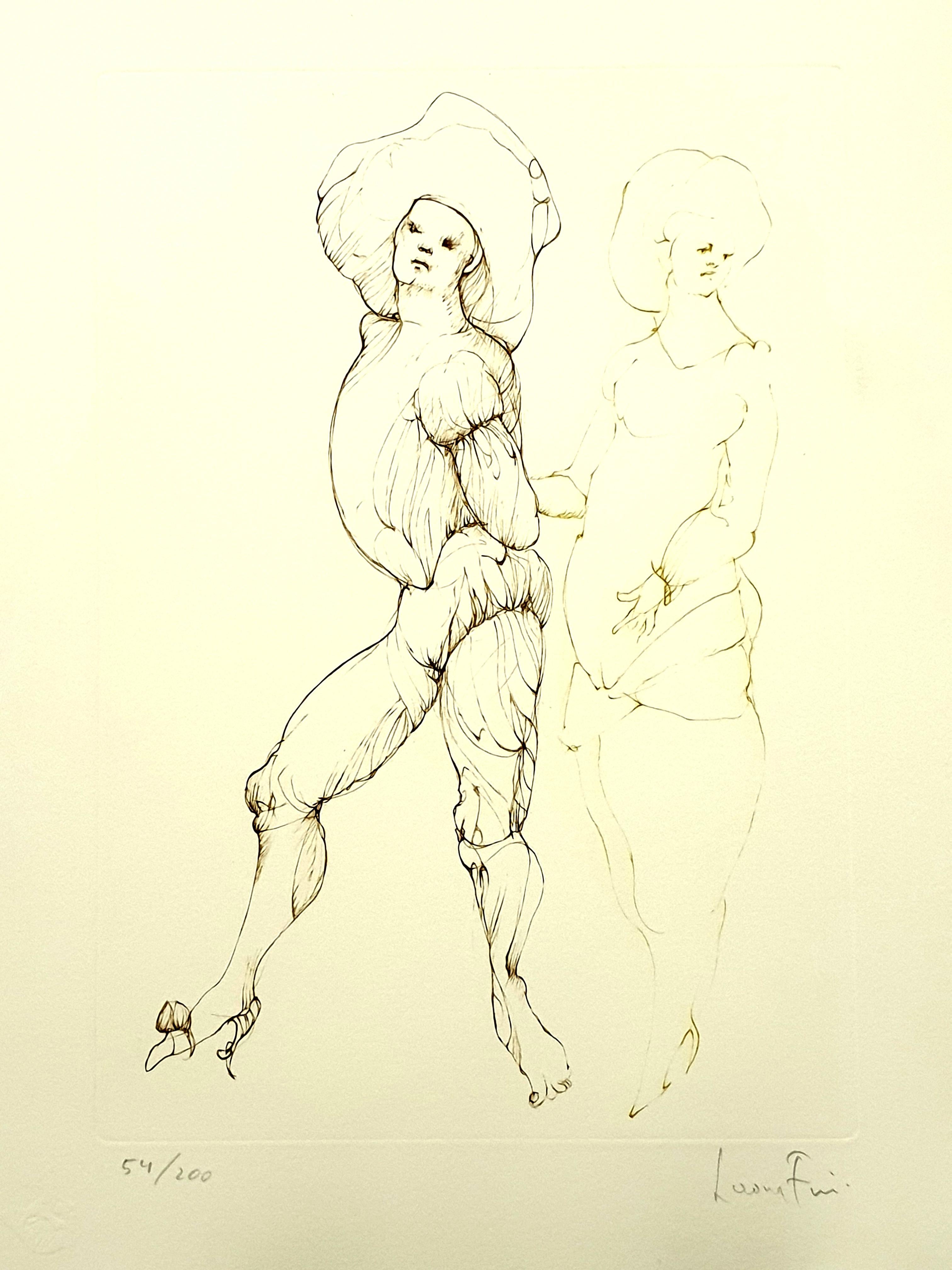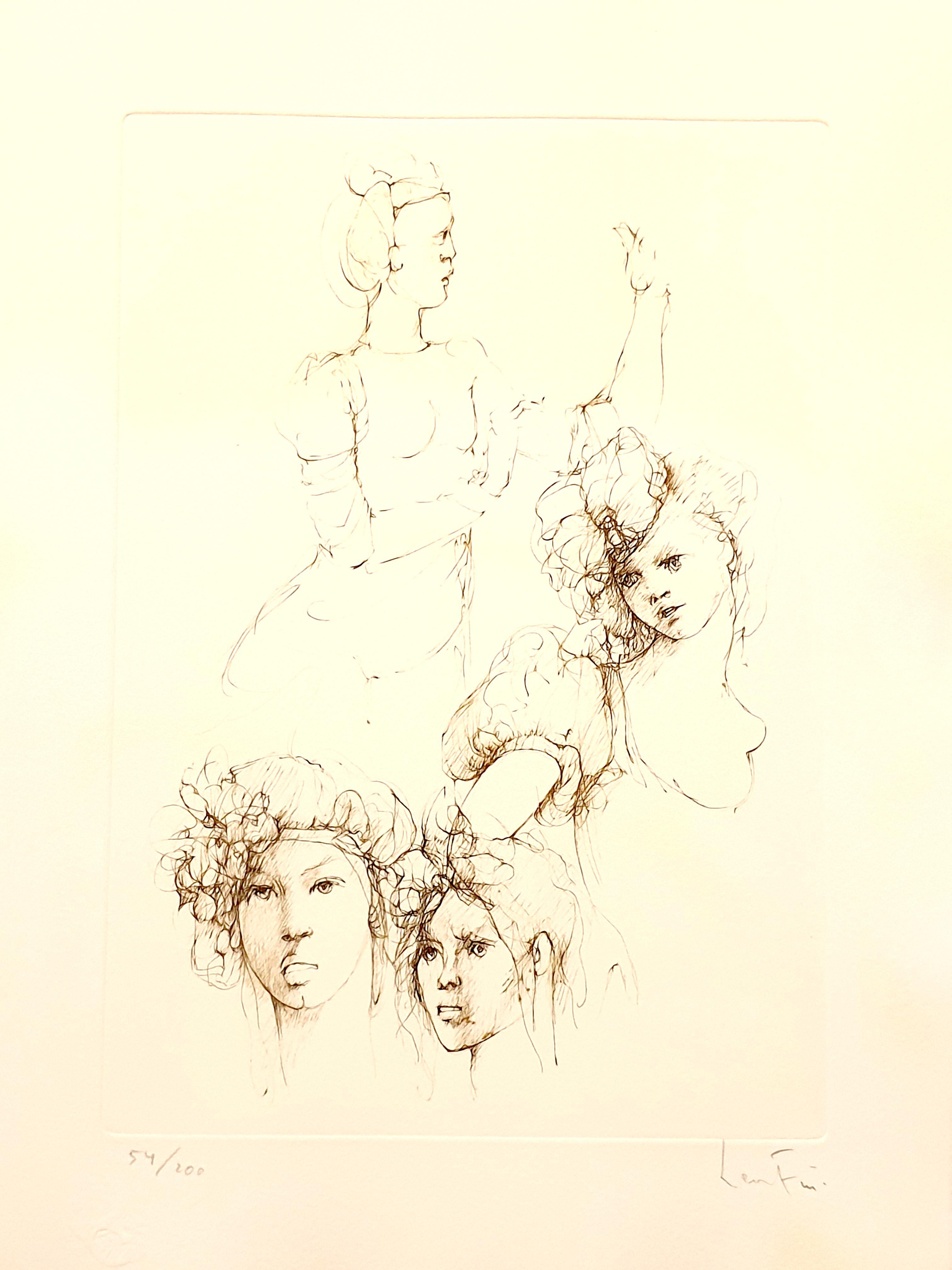Items Similar to André Minaux - Original Handsigned Lithograph - Ecole de Paris
Want more images or videos?
Request additional images or videos from the seller
1 of 11
Andre MinauxAndré Minaux - Original Handsigned Lithograph - Ecole de ParisCirca 1970
Circa 1970
About the Item
André Minaux
Original Handsigned Lithograph
Dimensions: 76 x 54 cm
Edition: HC XXI/XXX
HandSigned and Numbered
Ecole de Paris au seuil de la mutation des Arts
Sentiers Editions
André Minaux was one of the great painters of the “Ecole de Paris” and of the second mid twenty century.
Andre Minaux French, (1923 - 1986)
Andre Minaux
(b Paris, 5 Sept 1923). French painter and printmaker. He studied under Maurice Brianchon at the Ecole National Supérieure des Arts Décoratifs in Paris (1941–5). From 1944 he exhibited at the Salon d’Automne, Salon des Indépendants and Salon de Mai and had his first one-man show at the Galerie des Impressions d’Art in Paris in 1946. In 1949 he participated in the second Homme-Témoin group exhibition at the Galerie Claude and the same year won the Prix de la Critique.
The social realism of Homme-Témoin was in tune with Minaux’s own work, in which he pared away detail and employed thickly painted, expressive brushstrokes in subdued colours to depict everyday scenes, as in Seated Woman (c. 1949; see Chevalier, pl. 4). In the same style were a number of townscapes, such as Landscape of Toury Ferrotes (1950; Paris, Pompidou), and such still-lifes as Armchair in an Interior (1951; London, Tate). He also made lithographs to illustrate books, for example Jules Amédée Barbey d’Aurevilly’s L’Ensorcelée (1955), Jules Renard’s Les Philippe (1958) and Blaise Cendrars’s La Grande Route. In 1960 Minaux exhibited the large work The Wedding (1957–60; see Besson, pl. 1) at the Maison de la Pensée Française in Paris.
Covering an area of 20 sq. m, the painting depicted an interior scene with figures gathered in celebration, which was compared by contemporaries to Gustave Courbet’s Burial at Ornans (1849–50; Paris, Mus. d’Orsay). From the 1960s his colours brightened yet his work became more serene, although the subject-matter remained the same. In the 1970s he concentrated on the theme of women in interiors in a series of coloured etchings, where the forms were flattened and abstracted, as in Denise. Also in the 1970s he made etchings of still-lifes mainly depicting elements taken from the artist’s studio, as in Two Palettes.
- Creator:Andre Minaux (1923 - 1986, French)
- Creation Year:Circa 1970
- Dimensions:Height: 29.93 in (76 cm)Width: 21.26 in (54 cm)Depth: 0.04 in (1 mm)
- Medium:
- Movement & Style:
- Period:
- Condition:
- Gallery Location:Collonge Bellerive, Geneve, CH
- Reference Number:1stDibs: LU16121800403
About the Seller
4.9
Platinum Seller
These expertly vetted sellers are 1stDibs' most experienced sellers and are rated highest by our customers.
Established in 2015
1stDibs seller since 2015
908 sales on 1stDibs
Typical response time: 1 hour
- ShippingRetrieving quote...Ships From: Collonge Bellerive, Geneve, Switzerland
- Return PolicyA return for this item may be initiated within 7 days of delivery.
More From This SellerView All
- Leonor Fini - Sitting - Original LithographBy Leonor FiniLocated in Collonge Bellerive, Geneve, CHLeonor Fini - Sitting - Original Lithograph The Flowers of Evil 1964 Conditions: excellent Edition: 500 Dimensions: 46 x 34 cm Editions: Le Cercle du Livre Précieux, Paris Unsigned...Category
1960s Modern Nude Prints
MaterialsLithograph
- Marc Chagall - Colorful Bible - Original LithographBy Marc ChagallLocated in Collonge Bellerive, Geneve, CHMarc Chagall, Original Lithograph depicting an instant of the Bible. Technique: Original lithograph in colours Year: 1956 Sizes: 35,5 x 26 cm / 14" x 10.2" (sheet) Published by: Édit...Category
1950s Modern Figurative Prints
MaterialsLithograph
- Leonor Fini - Pleasure - Original LithographBy Leonor FiniLocated in Collonge Bellerive, Geneve, CHLeonor Fini - Pleasure - Original Lithograph The Flowers of Evil 1964 Conditions: excellent Edition: 500 Dimensions: 46 x 34 cm Editions: Le Cercle du Livre Précieux, Paris Unsigne...Category
1960s Modern Nude Prints
MaterialsLithograph
- Marc Chagall - The Bible - Original LithographBy Marc ChagallLocated in Collonge Bellerive, Geneve, CHMarc Chagall, Original Lithograph depicting an instant of the Bible. Technique: Original lithograph in colours Year: 1956 Sizes: 35,5 x 26 cm / 14" x 10.2" (sheet) Published by: Éditions de la Revue Verve, Tériade, Paris Printed by: Atelier Mourlot, Paris Documentation / References: Mourlot, F., Chagall Lithograph [II] 1957-1962, A. Sauret, Monte Carlo 1963, nos. 234 and 257 Marc Chagall (born in 1887) Marc Chagall was born in Belarus in 1887 and developed an early interest in art. After studying painting, in 1907 he left Russia for Paris, where he lived in an artist colony on the city’s outskirts. Fusing his own personal, dreamlike imagery with hints of the fauvism and cubism popular in France at the time, Chagall created his most lasting work—including I and the Village (1911)—some of which would be featured in the Salon des Indépendants exhibitions. After returning to Vitebsk for a visit in 1914, the outbreak of WWI trapped Chagall in Russia. He returned to France in 1923 but was forced to flee the country and Nazi persecution during WWII. Finding asylum in the U.S., Chagall became involved in set and costume design before returning to France in 1948. In his later years, he experimented with new art forms and was commissioned to produce numerous large-scale works. Chagall died in St.-Paul-de-Vence in 1985. The Village Marc Chagall was born in a small Hassidic community on the outskirts of Vitebsk, Belarus, on July 7, 1887. His father was a fishmonger, and his mother ran a small sundries shop in the village. As a child, Chagall attended the Jewish elementary school, where he studied Hebrew and the Bible, before later attending the Russian public school. He began to learn the fundamentals of drawing during this time, but perhaps more importantly, he absorbed the world around him, storing away the imagery and themes that would feature largely in most of his later work. At age 19 Chagall enrolled at a private, all-Jewish art school and began his formal education in painting, studying briefly with portrait artist Yehuda Pen. However, he left the school after several months, moving to St. Petersburg in 1907 to study at the Imperial Society for the Protection of Fine Arts. The following year, he enrolled at the Svanseva School, studying with set designer Léon Bakst, whose work had been featured in Sergei Diaghilev's Ballets Russes. This early experience would prove important to Chagall’s later career as well. Despite this formal instruction, and the widespread popularity of realism in Russia at the time, Chagall was already establishing his own personal style, which featured a more dreamlike unreality and the people, places and imagery that were close to his heart. Some examples from this period are his Window Vitebsk (1908) and My Fianceé with Black Gloves (1909), which pictured Bella Rosenfeld, to whom he had recently become engaged. The Beehive Despite his romance with Bella, in 1911 an allowance from Russian parliament member and art patron Maxim Binaver enabled Chagall to move to Paris, France. After settling briefly in the Montparnasse neighborhood, Chagall moved further afield to an artist colony known as La Ruche (“The Beehive”), where he began to work side by side with abstract painters such as Amedeo Modigliani and Fernand Léger as well as the avant-garde poet Guillaume Apollinaire. At their urging, and under the influence of the wildly popular fauvism and cubism, Chagall lightened his palette and pushed his style ever further from reality. I and the Village (1911) and Homage to Apollinaire (1912) are among his early Parisian works, widely considered to be his most successful and representative period. Though his work stood stylistically apart from his cubist contemporaries, from 1912 to 1914 Chagall exhibited several paintings at the annual Salon des Indépendants exhibition, where works by the likes of Juan Gris, Marcel Duchamp and Robert Delaunay were causing a stir in the Paris art world. Chagall’s popularity began to spread beyond La Ruche, and in May 1914 he traveled to Berlin to help organize his first solo exhibition, at Der Sturm Gallery. Chagall remained in the city until the highly acclaimed show opened that June. He then returned to Vitebsk, unaware of the fateful events to come. War, Peace and Revolution In August 1914 the outbreak of World War I precluded Chagall’s plans to return to Paris. The conflict did little to stem the flow of his creative output, however, instead merely giving him direct access to the childhood scenes so essential to his work, as seen in paintings such as Jew in Green (1914) and Over Vitebsk (1914). His paintings from this period also occasionally featured images of the war’s impact on the region, as with Wounded Soldier (1914) and Marching (1915). But despite the hardships of life during wartime, this would also prove to be a joyful period for Chagall. In July 1915 he married Bella, and she gave birth to a daughter, Ida, the following year. Their appearance in works such as Birthday (1915), Bella and Ida by the Window (1917) and several of his “Lovers” paintings give a glimpse of the island of domestic bliss that was Chagall’s amidst the chaos. To avoid military service and stay with his new family, Chagall took a position as a clerk in the Ministry of War Economy in St. Petersburg. While there he began work on his autobiography and also immersed himself in the local art scene, befriending novelist Boris Pasternak, among others. He also exhibited his work in the city and soon gained considerable recognition. That notoriety would prove important in the aftermath of the 1917 Russian Revolution when he was appointed as the Commissar of Fine Arts in Vitebsk. In his new post, Chagall undertook various projects in the region, including the 1919 founding of the Academy of the Arts. Despite these endeavors, differences among his colleagues eventually disillusioned Chagall. In 1920 he relinquished his position and moved his family to Moscow, the post-revolution capital of Russia. In Moscow, Chagall was soon commissioned to create sets and costumes for various productions at the Moscow State Yiddish Theater, where he would paint a series of murals titled Introduction to the Jewish Theater as well. In 1921, Chagall also found work as a teacher at a school for war orphans. By 1922, however, Chagall found that his art had fallen out of favor, and seeking new horizons he left Russia for good. Flight After a brief stay in Berlin, where he unsuccessfully sought to recover the work exhibited at Der Sturm before the war, Chagall moved his family to Paris in September 1923. Shortly after their arrival, he was commissioned by art dealer and publisher Ambroise Vollard to produce a series of etchings for a new edition of Nikolai Gogol's 1842 novel Dead Souls. Two years later Chagall began work on an illustrated edition of Jean de la Fontaine’s Fables, and in 1930 he created etchings for an illustrated edition of the Old Testament, for which he traveled to Palestine to conduct research. Chagall’s work during this period brought him new success as an artist and enabled him to travel throughout Europe in the 1930s. He also published his autobiography, My Life (1931), and in 1933 received a retrospective at the Kunsthalle in Basel, Switzerland. But at the same time that Chagall’s popularity was spreading, so, too, was the threat of Fascism and Nazism. Singled out during the cultural "cleansing" undertaken by the Nazis in Germany, Chagall’s work was ordered removed from museums throughout the country. Several pieces were subsequently burned, and others were featured in a 1937 exhibition of “degenerate art” held in Munich. Chagall’s angst regarding these troubling events and the persecution of Jews in general can be seen in his 1938 painting White Crucifixion. With the eruption of World War II, Chagall and his family moved to the Loire region before moving farther south to Marseilles following the invasion of France. They found a more certain refuge when, in 1941, Chagall’s name was added by the director of the Museum of Modern Art (MOMA) in New York City to a list of artists and intellectuals deemed most at risk from the Nazis’ anti-Jewish campaign. Chagall and his family would be among the more than 2,000 who received visas and escaped this way. Haunted Harbors Arriving in New York City in June 1941, Chagall discovered that he was already a well-known artist there and, despite a language barrier, soon became a part of the exiled European artist community. The following year he was commissioned by choreographer Léonide Massine to design sets and costumes for the ballet Aleko, based on Alexander Pushkin’s “The Gypsies” and set to the music of Pyotr Ilyich Tchaikovsky. But even as he settled into the safety of his temporary home, Chagall’s thoughts were frequently consumed by the fate befalling the Jews of Europe and the destruction of Russia, as paintings such as The Yellow Crucifixion...Category
1950s Modern Figurative Prints
MaterialsLithograph
- Leonor Fini - Walking Dead - Original LithographBy Leonor FiniLocated in Collonge Bellerive, Geneve, CHLeonor Fini - Walking Dead - Original Lithograph The Flowers of Evil 1964 Conditions: excellent Edition: 500 Dimensions: 46 x 34 cm Editions: Le Cercle ...Category
1960s Modern Nude Prints
MaterialsLithograph
- Leonor Fini - Red-Haired Girl - Original LithographBy Leonor FiniLocated in Collonge Bellerive, Geneve, CHLeonor Fini - Red-Haired Girl - Original Lithograph The Flowers of Evil 1964 Conditions: excellent Edition: 500 Dimensions: 46 x 34 cm Editions: Le Cercle du Livre Précieux, Paris ...Category
1960s Modern Nude Prints
MaterialsLithograph
You May Also Like
- Untitled framed lithograph by Aristide MaillolBy Aristide MaillolLocated in Boca Raton, FLFramed lithograph of female nude of pastel by Aristide Maillol. Initials in lower-right corner. Framed under glass in wooden frame.Category
20th Century Modern Figurative Prints
MaterialsLithograph
- Untitled nude woman framed lithograph by artist Aristide MaillolBy Aristide MaillolLocated in Boca Raton, FLFramed lithograph of a female nude pastel by artist Aristide Maillol. Image size: 12 1/2 x 9 1/2 inches. Framed under glass in wooden frame.Category
20th Century Modern Figurative Prints
MaterialsLithograph
- Nude Lying Down framed lithograph of woman by artist Aristide MaillolBy Aristide MaillolLocated in Boca Raton, FLFramed lithograph of a female Nude Lying Down pastel by artist Aristide Maillol. Image size: 9 1/4 x 14 1/2 inches. Framed under glass in wooden frame.Category
20th Century Modern Figurative Prints
MaterialsLithograph
- Nu couché, jambe repliée - Étude de jambesBy Henri MatisseLocated in New York, NYHenri Matisse Nu couché, jambe repliée - Étude de jambes, 1925 lithograph on Japanese vellum, edition of 50 18 x 22 1/16 in. (45.7 x 56 cm)Category
1920s Modern Nude Prints
MaterialsLithograph
- Nu accroupi, profil à la chevelure noireBy Henri MatisseLocated in New York, NYHenri Matisse Nu accroupi, profil à la chevelure noire, 1906 lithograph on Japanese vellum, edition of 25 17 11/16 x 11 in. (44.9 x 27.9 cm)Category
Early 1900s Modern Nude Prints
MaterialsLithograph
- Nude original Lithograph EA by Alain BonnefoitBy Alain BonnefoitLocated in Pasadena, CAOriginal Lithographe EA (Epreuve d'Artiste ) Alain Bonnefoit’s trademark female nudes reflect both Western and Eastern art historical influences. A painter, engraver, and sculptor, B...Category
Late 20th Century Modern Figurative Prints
MaterialsLithograph
Recently Viewed
View AllMore Ways To Browse
1970 Nude Lithograph Prints
Etching Woman Nude
Modern Orange Nude
Mid Century Lithographs Woman
1970s Studio 54
Theme Vintage Wedding
Orange 1970s Armchair
Arts Decoratifs Books
Retro Themed Wedding
Maurice Orange
Les Sept
Prints By Courbet
Gustave Courbet
Maurice Chevalier
Andre Minaux
Le Temoin
Brianchon Artist
Minaux Lithograph





